|
|
|
Sort Order |
|
|
|
Items / Page
|
|
|
|
|
|
|
| Srl | Item |
| 1 |
ID:
155839
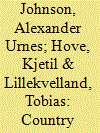

|
|
|
|
|
| Summary/Abstract |
This article examines military expenditure and defence policy in Norway from 1970 to 2013. Until 1990 Norwegian military expenditure remained between 2.5 and 3.0 per cent of Gross Domestic Product (GDP). Despite constant GDP shares, the military expenditure could not sustain a large and properly armed mobilization army. The constant nominal defence budgets of the 1990s accentuated the Norwegian Armed Forces' underlying imbalance between tasks, structure and budget. Around year 2000, large organizational reforms were effectuated, in which costs, the number of man-years, and underlying imbalances between tasks, structure and budget were reduced. Military expenditure increased in nominal terms between 2003 and 2013, while real military expenditure remained practically constant.
|
|
|
|
|
|
|
|
|
|
|
|
|
|
|
|
| 2 |
ID:
155845
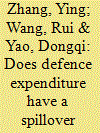

|
|
|
|
|
| Summary/Abstract |
China’s defence expenditure has been growing rapidly along with GDP growth during the past two decades. Meanwhile, the income gap has continued to increase. There are conflicting views regarding whether the defence expenditure is capable of reducing income inequality. Therefore, this paper investigates the existence of any spillover effect of defence expenditure on income inequality, with a special focus on the regional differences among 31 provinces and 7 military regions in China. We extend panel cointegration and the impulse response function by using panel data during the period of 1997–2012. The empirical results show that the defence expenditure has an impact on income inequality, and the effect varies over different regions in China. The defence expenditure has a spillover effect on income inequality in the full sample panel and the southeastern panel. An increase in the defence expenditure does not crowd out social welfare spending due to the high level of economic development and government expenditure. On the contrary, in the northern panel, the effect is opposite because of the unbalanced economic development levels within the panel. Beijing as the capital of China, benefits more from the expansion of defence expenditure thus widening the income gap. In addition, the impulse response analyses further confirm a stronger effect of the defence expenditure on income inequality in the northern and the southeastern panels over a short period.
|
|
|
|
|
|
|
|
|
|
|
|
|
|
|
|
| 3 |
ID:
155841
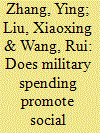

|
|
|
|
|
| Summary/Abstract |
Whether military spending is capable of promoting social welfare is currently a controversial issue. The aim of this paper is to investigate how military spending affects the input and output of social welfare (i.e. social welfare expenditures and social welfare index). A panel cointegration analysis and an impulse response function are conducted with multi-country panel data, over two time periods, 1998–2011 and 1993–2007. In addition, to extend a comparative analysis over different economies, BRICS (i.e. Brazil, Russia, India, China, South Africa) and G7 (i.e. the US, Japan, Germany, the UK, France, Italy, Canada) countries are selected as representatives of emerging economies and developed countries, respectively. The empirical results show that military spending enhances social welfare expenditures in developed countries, while the effect is ambiguous in emerging economies. Also, military spending is capable of promoting the social welfare index based on the FMOLS estimation. The comparative analyses indicate that unlike in the G7, the effect of the growth of military spending on the growth of social welfare expenditures is negative and shorter in the BRICS.
|
|
|
|
|
|
|
|
|
|
|
|
|
|
|
|
| 4 |
ID:
155842


|
|
|
|
|
| Summary/Abstract |
This study examines the relationship between defence spending, other components of public spending and economic growth for the 1952–2012 period in China using Granger causality tests and generalised impulse response functions based on vector error correction models. The empirical results reveal two long-run equilibrium relationships among the variables and also show that defence spending inversely and unidirectionally Granger impacts economic growth. Furthermore, empirical findings point to a trade-off relationship between defence spending and public expenditures in China. From a policy maker’s perspective, the findings reported herein imply that a decrease in defence spending may stimulate economic growth.
|
|
|
|
|
|
|
|
|
|
|
|
|
|
|
|
| 5 |
ID:
155837


|
|
|
|
|
| Summary/Abstract |
This paper empirically examines whether the aging of a fleet affects operational availability and operating cost using a unique data-set on the 117 47-foot Motor Lifeboats (MLBs) of the United States Coast Guard (USCG). Procured from 1997 to 2003, the 47-foot MLB is the standard lifeboat of the USCG and all 117 MLBs remain in service. The aging of the MLB fleet has resulted in higher annual operating costs and lower operational availability, although the nature of this relationship remains unclear. Our estimation strategy utilizes an error components estimator to examine these issues. We employ three variants of the dependent variables (i.e. the standard logarithmic transformation as is most commonly seen in the literature, inverse hyperbolic sine [IHS], and level outcomes). The point estimates from the standard logarithmic model finds operational availability for the MLBs decreases at a rate between 0.83 and 1.8% per year and cost increases at a rate between 0.33 and 7.81% per year. Similar effects are shown with the IHS and level outcome specifications. In terms of nonlinearity effects, we find the most pronounced changes in operational availability and cost occur for MLBs aged 15 years or more (in comparison to younger MLBs).
|
|
|
|
|
|
|
|
|
|
|
|
|
|
|
|
| 6 |
ID:
155836
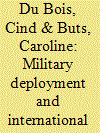

|
|
|
|
|
| Summary/Abstract |
Extant literature documents a relationship between military deployment and the risk of an international terrorist attack against citizens of the deploying country. It appears that deployment significantly increases the possibility of terrorist actions in the home country. In particular, if country A decides to send troops to nation B, then citizens of the former country are more likely to fall victim of an attack carried out by a terrorist organisation originating from the latter country. Contributing to this line of literature, we further refine this relationship by distinguishing between regions where the troops are sent as well as by introducing differences between types of deployment. Our results indicate that missions to Asia and the Middle East are more dangerous than missions to other regions as reflected by the terrorist threat in the home country. Robustness tests do however show that the significance of the location variable Asia is predominantly attributed to the mission to Afghanistan. As for types of deployment, only ad hoc missions seem to increase the risk of an attack, whereas no significant results are found for other missions such as operations under UN and NATO flag. Leaving out the missions to Iraq and Afghanistan however also increases the danger resulting from missions by fixed coalitions. Our results find however no evidence that ‘wearing a blue helmet’ increases the probability of a terrorist attack at home.
|
|
|
|
|
|
|
|
|
|
|
|
|
|
|
|
| 7 |
ID:
155843


|
|
|
|
|
| Summary/Abstract |
The economic growth effects of military expenditure have been the subject of a large literature in defence economics. Theories on the economic impacts of military expenditure greatly differ and include arguments that they either enhance economic growth or crowd out productive investments. Empirical literature on defence expenditure and economic growth nexus generally employs linear specifications to investigate the impact of defence expenditures on economic growth. Although it is now well established that many economic variables may have a non-linear data-generating mechanism, it seems that this reality has long been neglected in empirical work on defence–growth nexus. This paper attempts to fill this gap by employing non-linear panel data models to examine the effects of military expenditures on economic growth for Middle Eastern countries and Turkey, for the time period 1988–2012. Results show that the effect of military expenditure on economic growth is nonlinear such that the state of the economy actually determines the effect of the former on the latter. This is important not only in showing asymmetric relationship between these variables but also in revealing the reasons of mixed results of earlier literature.
|
|
|
|
|
|
|
|
|
|
|
|
|
|
|
|
| 8 |
ID:
155838
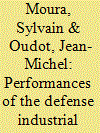

|
|
|
|
|
| Summary/Abstract |
This paper employs an economic and statistical approach to get an overview of the defense industrial base (DIB) in France. It allows us to identify its main characteristics and to measure the role of small and medium enterprises (SMEs). An original data-set was built, thanks to the information from the Ministry of Defense (MOD), the French Customs Central and National Administration, the Organization for Joint Armament Cooperation (OCCAR), the North Atlantic Treaty Organization (NATO), and all the most relevant organizations specialized in the development, production or maintenance, repair, and overhaul of military goods in France. Overall, the DIB turns out as being composed of about 1800 enterprises in France (subcontractors included), of which three-third are SMEs. Along with high market concentration ratios, these enterprises are characterized by a significant military/civil duality, high labor productivity rates, and intensity in Research and Development.
|
|
|
|
|
|
|
|
|
|
|
|
|
|
|
|
|
|
|
|
|